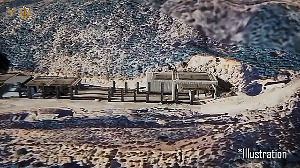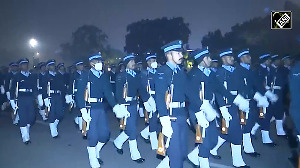What is the most distinguishing mark about Colachel? Streams of bleaching powder on both sides of the road.
In fact, bleaching powder is a constant presence across the tsunami-hit regions of Tamil Nadu. The old dependable disinfectant is cheap, effective and available in plenty.
Nature's destruction may not have discriminated but clearly the survivors have. At St Mary's school, where a relief camp was set up immediately after the tragedy, villagers from Colachel and Kuttilpadu, traditional rivals, went at each other. The district administration stepped in and moved the Kuttilpadu villagers to another camp. No wonder the school looks half empty.
Regardless of the numbers, Father Stanley, who heads the St Mary's camp, is busy. Not only was he providing relief but he was also consoling the victims. Like this woman who was yet to receive the Rs 1 lakh compensation for next of kin. The father advised her patiently that while the wheels of the administration ground slowly, it did grind; the cheque would certainly come.
Even the police turned to the parish priest often. Like this sub-inspector of police who was requesting him to file a second missing persons list since his first one, on the basis of which an FIR had been filed, was no more current. Father Stanley promptly gave him another list of 12 missing persons.
Some 615 deaths had been reported in Colachel while I was there, of which. 534 bodies had been identified. The police told Rediff.com that the number of missing more or less tallied with the number of unidentified bodies that were buried here.
The school compound was raucous, and the fishermen were right in the midst of it. They had been asked to move to the new temporary homes built by the government, and while they were keen on doing so what got their goat was the location.
The homes were built on the seashore, on the same spot from where their families were washed away. How could the government be so callous and inhuman, they wanted to know. Clearly things were not all well here; one sign of this was that the collector was transferred out, the locals say he never got out of his car in the disaster areas. The new collector had taken charge the day I was there, and his PA helpfully offered that the decision on the fishermen's houses was taken by the Karungal tahsildhar and the revenue divisional officer.
The RDO said he chose the seashore for two reasons. One, it was convenient for the fishermen to go fishing. Two, the fishermen themselves were helping with the construction so they cannot be unhappy. The fishermen, when I spoke to them, were apoplectic with rage. Why would we want to move back to the same spot where we lost all our beloved ones, are you mad?
Clearly someone was not being entirely truthful, and so I decided to visit the site of the new homes. Work was going on at a brisk pace, two earthmovers were levelling the site where the original hutments had been, and at one place they had already started construction work, and the homes would be ready in a couple of days time. But no, there were no fishermen helping out in the building work, the RDO was clearly mistaken.
The fishermen swore they will not live on the seashore, preferring the streets to this location.
Another frenetic site should be the government hospital but here peace reigned where a fortnight back it was a scene out of a nightmare. Chief Medical Officer A Thannammai said with an air of relief, "Work has been streamlined, we are back to normal."
Further down, a doctor in a private hospital says a potential epidemic had been averted in Colachel. Three patients were identified with a virulent form of chicken pox, and the government doctors promptly swung into action. The patients were quarantined in nearby Kulithurai, and people in medical relief camps were immediately vaccinated against chicken pox.
Clearly Colachel is getting back on its feet. The fishermen have started going out to sea, and the schools will have opened. But this is the Colachel that is left after burying 615 people.
Outside the travellers bungalow from where the relief work is being coordinated is Manikandan. His father Ayyapan was one of the victims of the tsunamis, and he is awaiting his compensation of Rs 1 lakh. Yes, the wheels of government grind slowly
Previous: A deluge of aid now
Next: Angel in a white coat






 © 2025 Rediff.com -
© 2025 Rediff.com -